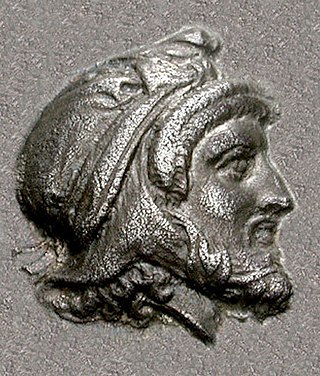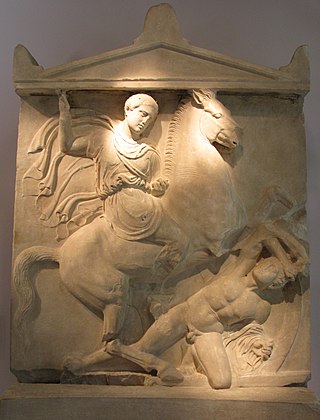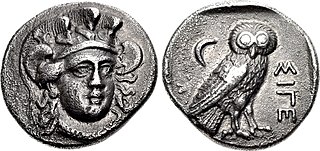This article concerns the period 379 BC – 370 BC.
This article concerns the period 369 BC – 360 BC
This article concerns the period 359 BC – 350 BC.
Year 424 BC was a year of the pre-Julian Roman calendar. At the time, it was known as the Year of the Tribunate of Crassus, Fidenas, Rutilus and Iullus. The denomination 424 BC for this year has been used since the early medieval period when the Anno Domini calendar era became the prevalent method in Europe for naming years.
Artabazos was a Persian general in the army of Xerxes I, and later satrap of Hellespontine Phrygia under the Achaemenid dynasty, founder of the Pharnacid dynasty of satraps. He was the son of Pharnaces, who was the younger brother of Hystaspes, father of Darius I. Artabazos was therefore a first cousin of the great Achaemenid ruler Darius I.

Pharnabazus II was a Persian soldier and statesman, and Satrap of Hellespontine Phrygia. He was the son of Pharnaces II of Phrygia and grandson of Pharnabazus I, and great-grandson of Artabazus I. He and his male ancestors, forming the Pharnacid dynasty, had governed the satrapy of Hellespontine Phrygia from its headquarters at Dascylium since 478 BC. He married Apama, daughter of Artaxerxes II of Persia, and their son Artabazus also became a satrap of Phrygia. According to some accounts, his granddaughter Barsine may have become Alexander the Great's concubine.

Chabrias was an Athenian general active in the first half of the 4th century BC. During his career he was involved in several battles, both on land and sea. The orator Demosthenes described him as one of the most successful commanders Athens ever had:
To sum up the whole: he is the only general who never lost a single city or post or ship or soldier, when he commanded you: none of your enemies has any trophy over you and him, while you have many over many enemies under his command.

The Corinthian War was a conflict in ancient Greece which pitted Sparta against a coalition of city-states comprising Thebes, Athens, Corinth and Argos, backed by the Achaemenid Empire. The war was caused by dissatisfaction with Spartan imperialism in the aftermath of the Peloponnesian War, both from Athens, the defeated side in that conflict, and from Sparta's former allies, Corinth and Thebes, who had not been properly rewarded. Taking advantage of the fact that the Spartan king Agesilaus II was away campaigning in Asia against the Achaemenid Empire, Thebes, Athens, Corinth and Argos forged an alliance in 395 BC with the goal of ending Spartan hegemony over Greece; the allies' war council was located in Corinth, which gave its name to the war. By the end of the conflict, the allies had failed to end Spartan hegemony over Greece, although Sparta was durably weakened by the war.

Timotheus was a Greek statesman and general who sought to revive Athenian imperial ambitions by making Athens dominant in a Second Athenian League. He was the son of the Athenian general, Conon. Isocrates considered that Timotheus was superior to the other commanders of his time and showed all the requisites and abilities of a good general.
Charidemus, of Oreus in Euboea, was an ancient Greek mercenary leader of the 4th century BC. He had a complicated relationship with Athens, sometimes aiding the city in its efforts to secure its interests in the northern Aegean, sometimes working against it. He was castigated by Demosthenes in his oration Against Aristocrates for repeated treacherous actions toward Athens, yet later he received Athenian citizenship and was elected one of its generals. In this capacity he ran afoul of Alexander III of Macedon and was ordered into banishment after the destruction of Thebes in 335. He retired to Persia, where he was first honored by the Great King, but was later executed after sneering at the quality of the Persian army.

Chares of Athens was a 4th-century BC Athenian military commander (Strategos), who for a number of years was one of Athens's foremost commanders. He was also a well connected politician enabling him to procure the commands he desired, commands he primarily used to enrich himself and his adherents.
The Social War, also known as the War of the Allies, was fought from 357 BC to 355 BC between Athens with the Second Athenian League and the allied city-states of Chios, Rhodes, Cos and Byzantion.
The "First Philippic" was delivered by the Athenian statesman and orator Demosthenes between 351 BC-350 BC. It constitutes the first speech of the prominent politician against Philip II of Macedon. A philippic refers to a type of speech that is negative in tone and one that is comparable to a rant or a tirade.
The Third Sacred War was fought between the forces of the Delphic Amphictyonic League, principally represented by Thebes, and latterly by Philip II of Macedon, and the Phocians. The war was caused by a large fine imposed in 357 BC on the Phocians by the Amphictyonic League, for the offense of cultivating sacred land; refusing to pay, the Phocians instead seized the Temple of Apollo in Delphi, and used the accumulated treasures to fund large mercenary armies. Thus, although the Phocians suffered several major defeats, they were able to continue the war for many years, until eventually all parties were nearing exhaustion. Philip II used the distraction of the other states to increase his power in central Greece, in the process becoming ruler of Thessaly. In the end, Philip's growing power, and the exhaustion of the other states, allowed him to impose a peaceful settlement of the war, marking a major step in the rise of Macedon to pre-eminence in Ancient Greece.
The Battle of Embata was a naval battle fought in 356 BC between the Chians and the Athenians led by Chares.

Pharnabazus III was a Persian satrap who fought against Alexander the Great. His father was Artabazos II, and his mother a Greek from Rhodes.

Under the reign of Philip II, the ancient kingdom of Macedonia, initially at the periphery of classical Greek affairs, came to dominate Ancient Greece in the span of just 25 years, largely thanks to the character and policies of its king. In addition to utilising effective diplomacy and marriage alliances to achieve his political aims, Philip II was responsible for reforming the ancient Macedonian army into an effective fighting force. The Macedonian phalanx became the hallmark of the Macedonian army during his reign and the subsequent Hellenistic period. His army and engineers also made extensive use of siege engines. Chief among Philip's Thracian enemies was the ruler Kersebleptes, who may have coordinated a temporary alliance with Athens. In a series of campaigns stretching from 356 to 340 BC, Philip II managed to ultimately subjugate Kersebleptes as a tributary vassal, conquering much of Thrace in the process. Philip II also fought against the Illyrian king Bardylis, who threatened Macedonia proper, and against Grabos II and Pleuratus in Illyria. In his newly conquered territories, he founded new cities such as Philippi, Philippopolis, Herakleia Sintike, and Herakleia Lynkestis.
Aristeus, son of Adeimantus, was a Corinthian general who commanded the expedition to Potidaea in 432 BC. After the Athenians broke a truce with the Corinthians at Sybota, his primary goal was to defend Potidaea from an Athenian attack. He then went on to defend the Corinthian colony from Athens during the Battle of Potidaea in 432 BC, until he was left with no option but to leave the colony with the Chalcidians. In 430 BC he traveled to Thrace with Spartan envoys where they were discovered by Athenians and brought to Athens, by Athenian ambassadors, where they were promptly killed without a trial. After Aristeus' death, Athens seized Potidaea in 430/429 BC during the Peloponnesian War, the battles of Sybota and Potidaea being two main catalysts for the war.
Philiscus or Philiskos was a 4th-century BC Greek tyrant of the city of Abydos, on the Asian side of the Hellespont, and a hyparch ("vice-regent") and military commander of the Achaemenid satrap Ariobarzanes. He was sent by Ariobarzanes in 368 BCE as an Achaemenid emissary to Delphi, where the Greek cities at war between themselves had assembled for peace negotiations. Philiscus had probably been sent at the request of either Athens or Sparta, to help solve the conflicts between the Greek city-states.

The siege of Perinthus was an unsuccessful attempt by Philip II of Macedon to defeat the Athenian forces at Perinthus, and take the city. The siege was conducted alongside an unsuccessful siege of Byzantium. Both sieges took place in the period just before the Fourth Sacred War.








